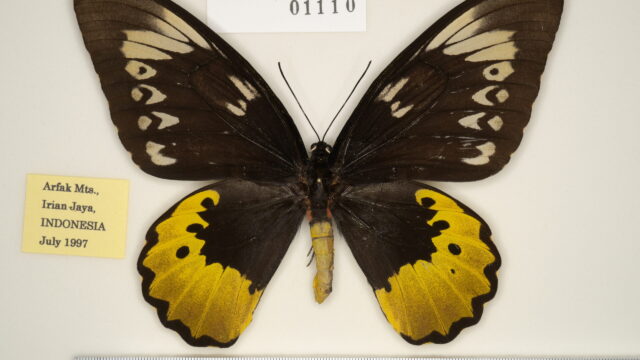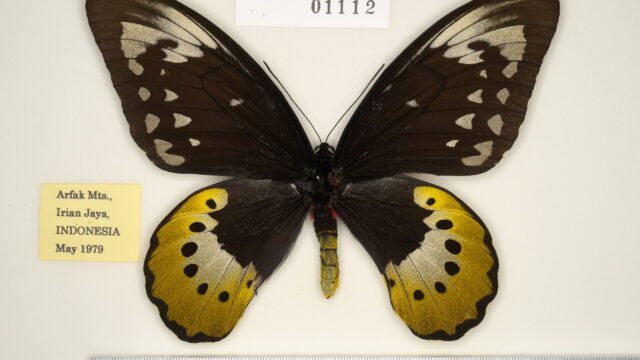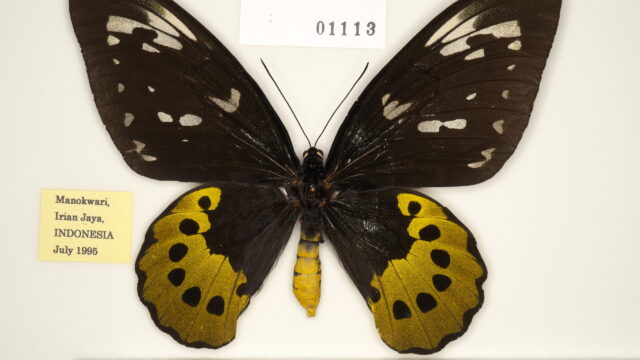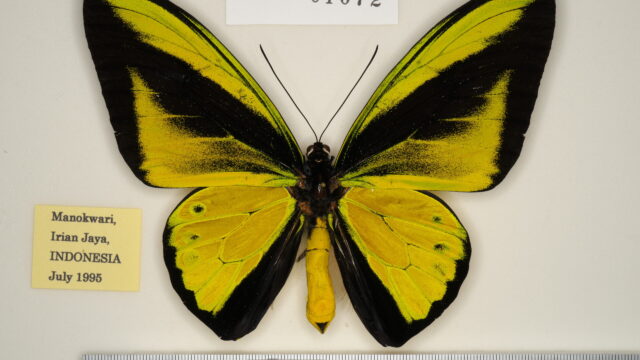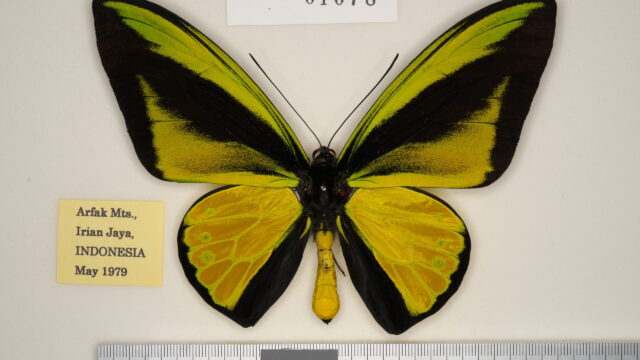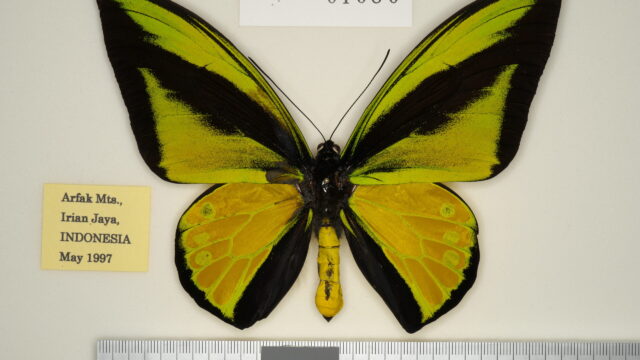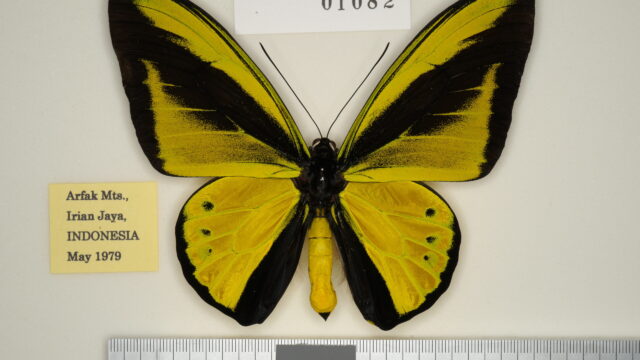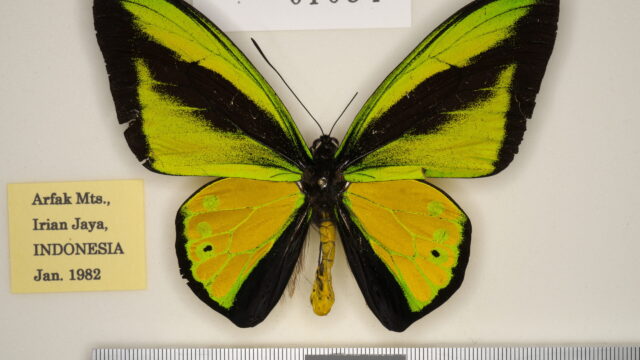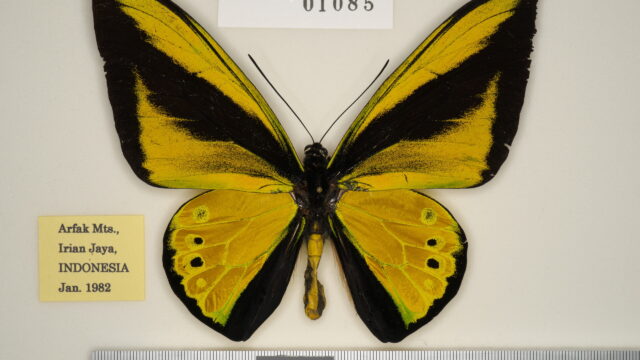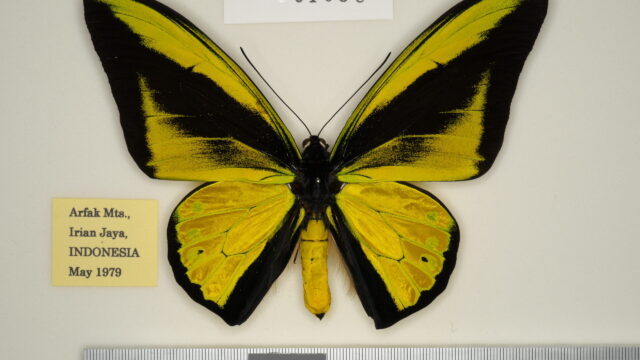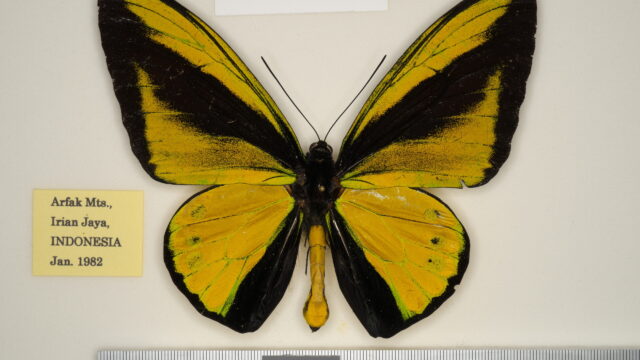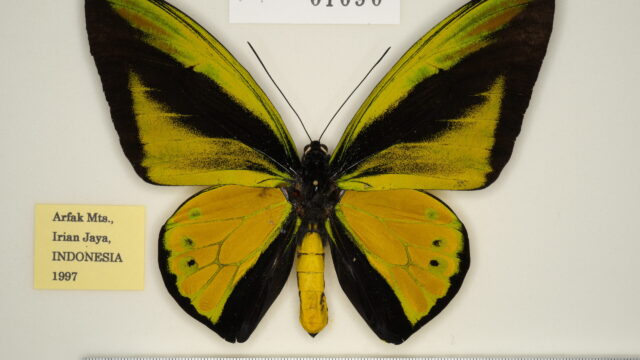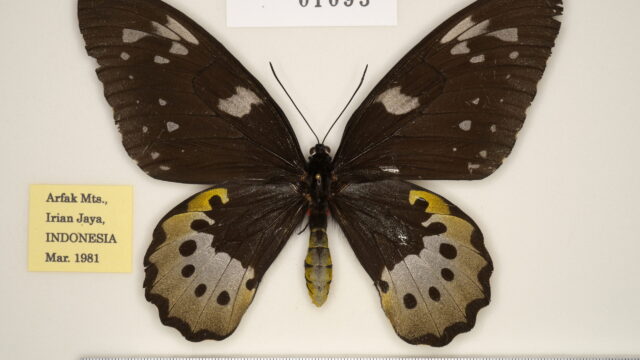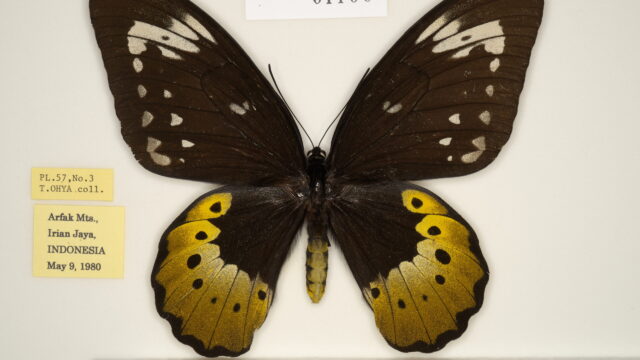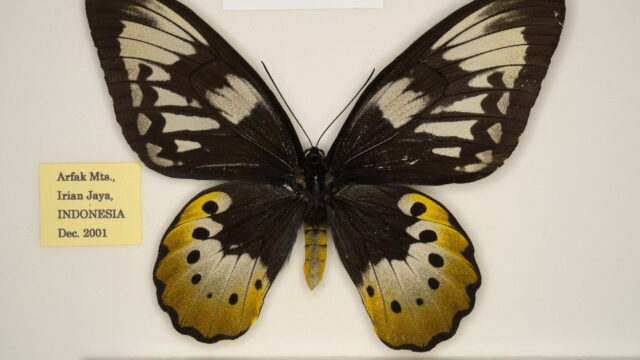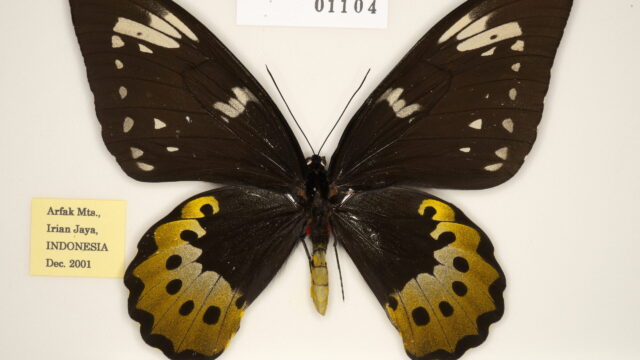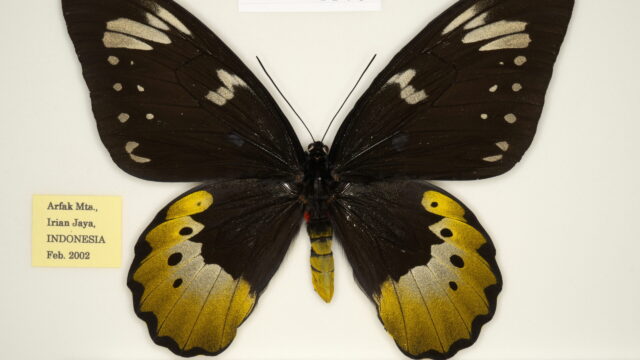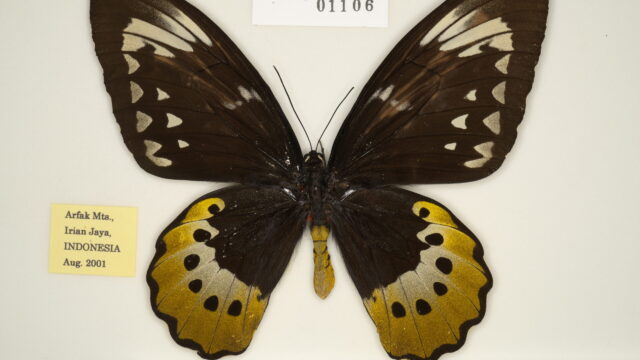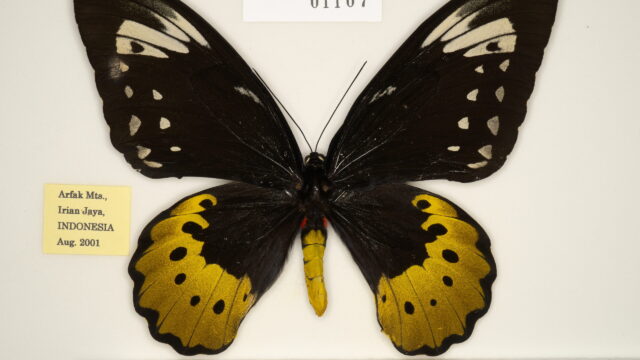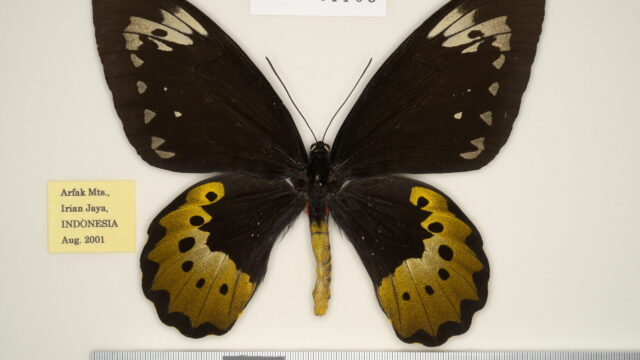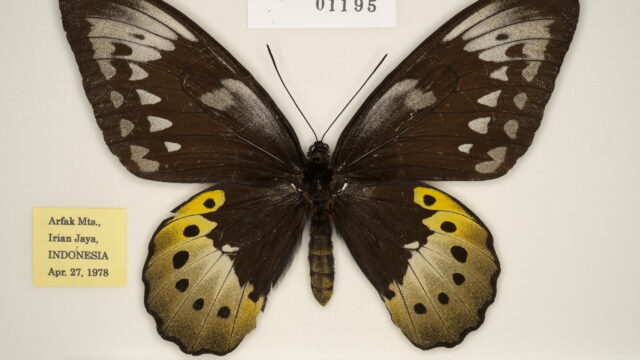- Ssp. samson Niepelt, 191315) [♂, ♀]
= joiceyi Noakes & Talbot, 191511) [♂, ♀] (Lake Angi, Arfak Mts.)
(Distribution) [Map 54]
INDONESIA [Irian Jaya] Doberai Peninsula (Manokwari, Arfak Mts. area (Meni, Minyambow, Dimaisi, Mt. Mebo (=Arfak), Ikumabow, Anggi Gigi area, Memti, Sibjo, Tobes, Mismel, Bikela)).
(Episodes of discovery and original description)
The first specimens were two pairs (date and collector unknown) collected in the Arfak Mountains area and designated by Niepelt in 1913 as species supremus f. samson (the Israelite hero betrayed by the Philistine beauty Delilah – Old Testament). On the other hand, Noakes and Talbot (1915) described a new species, joiceyi, based on a specimen of 1 ♂ and 1 ♀ collected by Pratt and his son from January to February 1914 at Lake Anggi (6000 feet) in the same area. It was dedicated to J.J. Joicey [1870-1932], founder of the Hill Museum and a well-known British entomologist. In that article, he compared it to goliath, titan, and supremus, but did not mention samson from the same locality. This suggests that he was unaware of Niepelt’s paper. The variants in the paper are presumably based on 16♂♂ and 8♀♀ collected in March of the same year.
Here is a piece on the first collection by Japanese researchers at Dimaisi (1800m alt.) on February 16, 1974, which appeared in Nishizawa, Takashi (1980) “The Expedition and Collecting in the West Irian”, Yadoriga, Vol. 101 and 102, p. 37. “At the confluence of two rivers, I found a red tree on the upper right side of the river. It was a very steep cliff, but we managed to get to where we wanted to go by making good footholds. The tree was only a few meters tall, and its flowers, which were more orange than red, were in full bloom. The tree was just at the tip of the peak. We suppressed our eagerness and hoped for the best. We could hear the time sizzling. However, clouds were gradually gathering in the sky. In general, clear skies all day long are not something that can be expected in West Irian. “Mr. Ishikawa, I don’t know if this will work.” “It fits my image perfectly. ……” Suddenly, a large, dazzling butterfly emerged from the virgin forest behind us. After gliding quickly, it reversed its wings in front of the flower and braked suddenly. For a moment, the butterfly perched on a point in space. That is what it looked like to me. I had been crouching down, but as I stood up, I swung down the net. I guess this kind of thing is called a conditioned reflex. With a flurry of movement, the butterfly, beautifully colored green, black, and gold, was struggling in the net that I had placed face down. I had finally done it! It was the first chance I had ever had. I wondered if this was possible ……. It was a genuine male Ornithoptera goliath. It was a large one with not a scratch on it. It was indeed very heavy. It appeared again along the same course. This time, Mr. Ishikawa caught it. It seemed like a long time had passed. It was raining before we knew it, and we were so excited that we didn’t even notice we were getting wet. And then, feeling somewhat reluctant to leave, we headed back home. Perhaps because of our excitement, we fell down many times. Every time I fell, I opened the container to see what was inside. All the hardships of the many trips to the police and the immigration office, and the hardships of the caravan, were now gone. All I could do was relive each moment of that golden-green glow. That night, I had a surprisingly high fever, and my thermometer read a little over 40 degrees Celsius. Perhaps it was a breakdown of the tension that had been sustaining my repeated fatigue, and perhaps it was also the result of my extreme excitement. On this day, I celebrated my 22nd birthday in the middle of the Arfak Mountains in West Irian.”
(Characteristics)
This subspecies occurs in very restricted area at altitudes of 1,000 – 2,000 m.
(Spotted pattern)
♂: No distinguishing characters from other subspecies except for the black hairs and black spots characteristic of highland subspecies on the lateral abdomen. (Individuals vary, rarely lacks black spots.)
♀: Individual variation is remarkable. In most specimens, FW spots are moderate in size and strongly obscure by shades of gray. HW pale band is gray with ochre submarginal area, some with a strong shade of gray, others entirely ochre. The abdomen of some individuals is speckled with black and yellow, while others are entirely yellow.
(Variation)
♂-f. sumulei Deslisle & Sclavo, 20154): [Aberrant FW pattern] The radial and cubital bands greatly extended and connected subapically. Presence of two semi-translucent golden streaks within cell, each at the top and the bottom of cell, and one within space 2 basally.
♂-f. primitus Deslisle & Sclavo, 20154) (➡ procus )
♂-f. joiceyi Noakes & Talbot, 191511): [FW/HW discoloration] FW iridescent green is strongly tinged with gold.
♂-f. letiranti Deslisle & Sclavo, 20083): [FW/HW discoloration] Red coloration on both FW/ HW instead of typical green, except basally and costally within the radial band.
♂-f. sanguismaculata Deslisle & Sclavo, 20154): [FW discoloration] Subapical and discal areas distally colored by blood-red scales on FW. (➡supremus, titan )
♀-f. mirificus Deslisle & Sclavo, 20154): [Aberrant FW/HW pattern] Blackish ground color. Subapical streaks are small, cell spot and submarginal spots are tiny on FW. HW pale band is yellow. Dark discal spots are vestigial in spaces 5 to 7, missing in lower ones.
♀-f. praeclarus Deslisle & Sclavo, 20154): [Aberrant FW/HW pattern] Pale spots enormously extended on FW. On HW, pale band also extended basally, moreover, dark discal spots smaller, blurred in spaces 3 and 4.
♀-f. samson Niepelt, 191315): [Aberrant FW pattern] FW without cell-spot.
♀-f. flavomaculata Sumiyoshi, 198925): [Aberrant HW pattern] HW pale band is enlarged and cell-spot also present, and dark yellow in color. The dark discal spots are tiny.
♀-f. subalbus Deslisle & Sclavo, 20083): [FW/HW discoloration] FW/HW upper/under sides, pale spots whitish and without any yellow scaling on HW.
♀-f. solaris Dufek & Schäffler, 20065): [FW/HW discoloration] All pale spots except discal spots on FW, and HW pale band are yellow in color.
♀-f. inaurareus Deslisle & Slavo, 20154): [FW/HW discoloration] Pale area a bright light yellow on both FW and HW. On FW, narrow iridescent green bands on the cost and the inner margin. Dark discal spots of HW are larger.
♀-f. roseus Deslisle & Sclavo, 20154): [FW discoloration] Pale spots are yellow and partially light pink on outer marginal region of FW upper/under surfaces.
♀-f. rubra Dufek & Schäffler, 20065): [HW discoloration] Typical yellow color on HW pale band is partially replaced by red scales.
